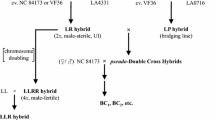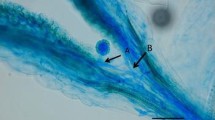Summary
Five- to seven-day-old ovaries from Triticum aestivum vars Hope (non-crossable), Chinese Spring (CS, crossable) and the chromosomal substitution line Chinese Spring/Hope 5B (CS/H5B) were used to test the hypothesis that an ovarian substance inhibits rye (Secale cereale var Wrens) pollen tube growth. In vitro assays on a semi-solid medium demonstrated that a soluble, dialyzed lysate from Hope or CS/H5B ovaries inhibited rye pollen tube elongation significantly more than a similar lysate from CS ovaries (26%, 13% and 5% respectively compared to controls). When only the 20 longest tubes from each sample were included in the analysis the relationship was maintained (33%, 22% and 15% for Hope, CS/H5B and CS respectively). Heating the Hope lysate at 100° C for 10 min reduced the inhibition from 26% to 14% for all pollen tubes measured (n = 51 per sample) and from 33% to 20% when only the 20 longest pollen tubes per sample were analyzed. Isoelectric focusing followed by sodium dodecyl sulfate polyacrylamide electrophoresis (IEF/SDS-PAGE) and non-equilibrium pH gradient electrophoresis (NEPHGE) revealed several differences in the polypeptide profiles of soluble lysates from vars Hope, CS and CS/H5B. While two striking differences were observed, a 50 kilodalton (kD) polypeptide with an isoelectric point (pI) of approximately 8.5 and 100 kD polypeptide (pI∼4) from CS lysates which were considerably reduced in lysates of Hope and CS/H5B, none were obviously associated with the Hope 5B chromosome and therefore cross-incompatibility.
Similar content being viewed by others
References
Anderson, M.A., E.C. Cornish, S.-L. Mau, E.G. Williams, R. Hoggart, A. Atkinson, I. Bonig, B. Grego, R. Simpson, P.J. Roche, J.D. Haley, J.D. Penschow, H.D. Niall, G.W. Tregear, J.P. Coghlan, R.J. Crawford & A.E. Clarke, 1985. Cloning of cDNA for a stylar glycoprotein associated with expression of self-incompatibility in Nicotiana alata. Nature 321: 38–44.
Bennett, M.D., M.K. Rao, J.B. Smith & M.W. Bayliss, 1973. Cell development in the anther, the ovule, and the young seed of Triticum aestivum L. var. Chinese Spring. Phil. Trans. R. Soc. Lond. B. 266: 39–81.
Blum, H., H. Beier & H.J. Gross, 1987. Improved silver staining of plant proteins, RNA and DNA in polyacrylamide gels. Electrophoresis 8: 93–99.
Bradford, M., 1976. A rapid and sensitive method for quantitation of microgram quantities of protein utilizing the principle of protein-dye binding. Anal. Biochem. 72: 248–254.
Clarke, A.E., M.A. Anderson, T. Bacic, P.J. Harris & S.-L. Mau, 1985. Molecular basis of cell recognition during fertilization in higher plants. J. Cell Sci. Suppl. 2: 261–285.
Falk, D.E. & K.J. Kasha, 1981. Comparison of the crossability of rye (Secale cereale) and Hordeum bulbosum onto wheat (Triticum aestivum). Can. J. Genet. Cytol. 23: 81–88.
Falk, D.E. & K.J. Kasha, 1983. Genetic studies of the crossability of hexaploid wheat with rye and Hordeum buldosum. Theor. Appl. Genet. 64: 303–307.
Fedak, G. & P.Y. Jui, 1982. Chromosomes of Chinese Spring wheat carrying genes for crossability with Betzes barley. Can. J. Genet. Cytol. 24: 227–233.
Harris, P.J., J.A. Weinhandl & A.E. Clarke, 1989. Effect on in vitro pollen growth of an isolated style glycoprotein associated with self-incompatibility in Nicotiana alata. Plant Physiol. 89: 360–367.
Jahnen, W., W.M. Lush & A.E. Clarke, 1989. Inhibition of in-vitro pollen tube growth by isolated S-glycoproteins of Nicotiana alata. The Plant Cell 1: 501–510.
Jalani, B.S. & J.P. Moss, 1980. The site of action of the crossability genes (Kr1, Kr2) between Triticum and Secale. I. Pollen germination, pollen tube growth, and number of pollen tubes. Euphytica 29: 571–579.
Knox, R.B., R.R. Willing & A.E. Ashford, 1972. Role of pollen-wall proteins as recognition substances in interspecific incompatibility in Poplars. Nature 237: 381–383.
Laemmli, U.K., 1980. Cleavage of structural proteins during the assembly of the head of the bacteriophage T4. Nature 227: 680–685.
Lange, W. & B. Wojciechowska, 1976. The crossing of common wheat (Triticum aestivum L.) with cultivated rye (Secale cereale L.). I. Crossability, pollen grain germination and pollen tube growth. Euphytica 25: 609–620.
Laurie, D.A. & M.D. Bennett, 1987. The effect of the crossability loci Kr1 and Kr2 on fertilization frequency in hexaploid wheat × maize crosses. Theor. Appl. Genet. 73: 403–409.
Lein, A., 1943. Die genetische Grundlage der Kreuzbarkeit zwischen Weizen und Roggen. Z. indukt. Abstamm-u. VererbLehre 81: 28–61.
Mau, S.-L., E.G. Williams, A. Atkinson, M.A. Anderson, E.C. Cornish, B. Grego, R.J. Simpson, A. Kheyr-Pour & A.E. Clarke, 1986. Style protein of a wild tomato (Lycopersicon peruvianum) associated with expression of self-incompatibility. Planta 169: 184–191.
O'Farrell, P.H., 1975. High resolution two dimensional electrophoresis of proteins. J. Biol. Chem. 250: 4007–4021.
O'Farrell, P.Z., H.M. Goodman & P.H. O'Farrell, 1977. High resolution two dimensional electrophoresis of basic as well as acidic proteins. Cell 12: 1133–1142.
Riley, R. & V. Chapman, 1967. The inheritance in wheat of crossability with rye. Genet. Res., Camb. 9: 259–267.
SAS Institute, Inc., 1985. SAS/STAT™ Guide for personal computer version 6 edition, Cary, NC: SAS Institute, Inc., 375 pp.
Sears, E.R., W.Q. Loegering & H.A. Rodenhiser, 1957. Identification of chromosomes carrying genes for stem rust resistance in four varieties of wheat. Agron. J. 49: 208–212.
Simonds, W.F., G. Koski, R.A. Streaty, L.J. Hjelmeland & W.A. Klee, 1980. Solubilization of active opiate receptors. Proc. Natl. Acad. Sci. USA 77: 4623–4627.
Sukaimi, J.B., 1973. Crossability, cytogenetics and fertility in Graminae. PhD Dissertation, University of Reading, Reading.
Taylor, J.W. & K.S. Quisenberry, 1935. Inheritance of rye crossability in wheat hybrids. J. Am. Soc. Agron. 27: 149–153.
Tozu, T., 1966. Crossability between wheat and rye. Seiken Ziho 18: 33–38.
Williams, E.G., S. Ramm-Anderson, C. Dumas, S.-L. Mau & A.E. Clarke, 1982. The effect of isolated components of Pisum avium L. styles on in vitro growth of pollen tubes. Planta 156: 517–519.
Author information
Authors and Affiliations
Additional information
Mention of a trademark or proprietary product is for identification only and does not imply a guarantee or warranty of the product by the U.S. Department of Agriculture.
Rights and permissions
About this article
Cite this article
Cameron, R.G., Reger, B.J. Hybridization barriers between wheat and rye: In vitro pollen assays and electrophoretic survey. Euphytica 52, 147–153 (1991). https://doi.org/10.1007/BF00029390
Received:
Accepted:
Issue Date:
DOI: https://doi.org/10.1007/BF00029390




